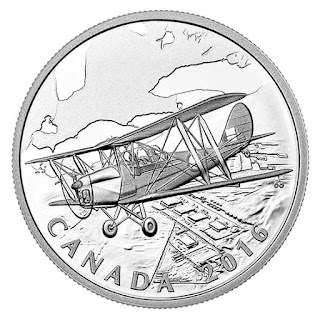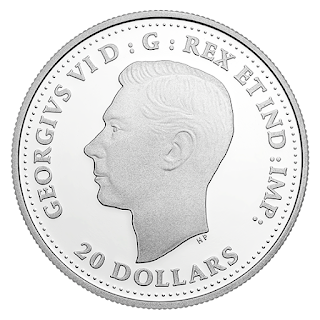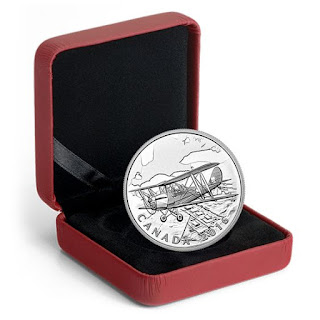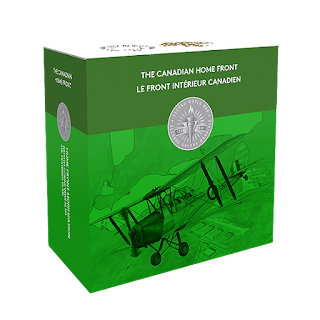Canada 20 Dollars Silver Coin 2016 British Commonwealth Air Training Plan
The Canadian Home Front four-coin series
Commemorates one of the largest multinational aviation training programs in history!
During the Second World War, much of the sky above Canada was alive with the sound of humming propellers. Every province except Newfoundland helped train more than 130,000 air cadets from Canada, Australia, New Zealand, Great Britain and other allied countries as pilots, radio operators, gunners, crew members and flight engineers. The The British Commonwealth Air Training Plan (BCATP) was one of the largest multinational aviation training programs in history, with its legacy still visible in the airfields and regional airports that dot the country, and in Canada's.This commemorative coin is a beautiful addition to any military, naval, or history-themed collection!
Special features:
This coin is the third in the Canadian Home Front four-coin series, which reflects on the war's profound impact in Canada.
This 99.99% pure silver coin proudly commemorates the important role played by the BCATP in the Canadian war effort at home.
EACH COIN IN THE SERIES FEATURES AN ENGRAVED MAP ELEMENT to provide geographical context to the theme; this coin's reverse design brings the focus to southern Ontario as a Tiger Moth aircraft flies over an overhead view of a BCATP training school in Malton, Ontario.
Exceptionally detailed engraving and beautiful finishes come together in this highly-detailed design.
The obverse features the effigy of King George VI, who was the reigning monarch during the Second World War.
This coin is crafted from 99.99% pure silver, is GST/HST exempt, and has a limited worldwide mintage.
About the Design:
Designed by Canadian artist David A. Oram, your coin presents an intricately detailed image that is brought to life through stunning finishes and meticulous engraving. Two airmen take to the skies in a de Havilland DH82A Tiger Moth biplane, which was used as a basic trainer for would-be pilots training in Canada during the Second World War. This close view allows the viewer to glimpse the struts and flying wires that held the wooden wings in place in their stacked position. This “winterized” version also includes adaptations that were typical of the models produced in Downsview, Ontario, including a sliding cockpit canopy and a tailwheel instead of the usual skid. Here, the two-place, fixed-wing aircraft flies above the communities of southern Ontario, as outlined by the engraved map in the background. Below our two flyers is an overhead view of the No. 1 Elementary Flying Training School (EFTS) in Malton, Ontario, which illustrates the layout of this BCATP training facility and runways.
It will establish Canada as one of the greatest air training centres of the world… – William Lyon Mackenzie King, Prime Minister of Canada
Signed into existence on December 17, 1939, the BCATP put Canada at the forefront of one of history's largest multinational aviation training programs. During the Second World War, over 130,000 air crew members from Canada, Australia, New Zealand, Great Britain and more trained as pilots, radio operators, gunners, bomb aimers, navigators and flight engineers in facilities across Canada, providing a boost to the country's aircraft manufacturing industry and aviation infrastructure.
Given its vast territory, the ideal flying conditions, its distance from enemy aircraft and proximity to American manufacturers, Canada was the ideal host for such a large-scale training endeavour. It proved to have a transformative effect on the home front: within months of the BCATP beginning its operations, every Canadian province (save for Newfoundland, which would join Canada in 1949) boasted a BCATP installation. Existing facilities received upgrades and fields were paved to create runways and tarmacs, resulting in more than 231 training sites from coast to coast. Canada's aircraft manufacturing industry also received a boost, with many aircraft, including the de Havilland Tiger Moths and twin-engine Avro Ansons specially built in Canadian factories.
Training began on April 29, 1940 in accordance with Royal Air Force and Royal Canadian Air Force (RCAF) syllabi, and was carried out by the RCAF with the support of flying clubs, commercial aviation companies and Canada's own Department of Transport. The recruits' learning progression was determined by their performance during initial training. Those destined to become aircrew members were assigned to schools dedicated to their specialty, whether it be as a bomb aimer, navigator, radio operator, air gunner or flight engineer; those who qualified to become pilots enrolled in an Elementary Flying Training School (EFTS), logging at least 50 hours of basic flying time in aircrafts such as the de Havilland Tiger Moth, the Fleet Finch and the Fairchild Cornell. Graduates could then move on to Service Flying Training School (SFTS) where the basics of combat flying were taught for fighter pilots on the North American Harvard, while aircrew training in bombing and maritime reconnaissance manned Avro Ansons, Cessna Cranes or Airspeed Oxfords. But the program was not without risk; 856 students were among at least 1,690 BCATP personnel who lost their lives during the program's five-year run, bringing a sense of loss and the tragedy of war to some of the host communities.
For Canadian civilians who had suffered through the Great Depression, the BCATP brought an economic boom to each host community; local construction crews sought out contracts to build the necessary infrastructure, while merchants supplied goods and services to the students and staff. Deep connections also formed between some of the recruits and their host communities, where community and service organizations ran canteens and organized activities to welcome these future aircrews and provide them with a taste of home.
The BCATP concluded March 31, 1945 but its impact is still visible on the Canadian landscape; many local airports across Canada owe their existence to the BCATP, or were significantly upgraded as part of the program's infrastructure. Canada's role in NATO air training is also directly linked to the legacy of the BCATP, which will be remembered forever more for training nearly half of the personnel that manned the Commonwealth's air forces during the war, and for earning Canada its reputation as the “aerodrome of democracy.”
Packaging: This coin is encapsulated and presented in a Royal Canadian Mint-branded maroon clamshell with a graphic beauty box.
Mintage: 7500.
Composition: 99.99% pure silver.
Finish: proof.
Weight: 31.39 g.
Diameter: 38 mm.
Edge: serrated.
Face value: 20 Canadian Dollars.
Artist: David A. Oram (reverse), Susanna Blunt (obverse).
Produced By: Royal Canadian Mint.
The Canadian Home Front four-coin series



